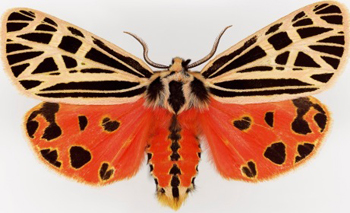How does the tiger tiger deter predators?
If you eat a sausage at a fast food store, you will definitely remember that experience whenever you see the brand of that sausage. Tiger butterflies also apply similar psychological rules to drive away predators.
For some birds and bats, virgin tiger butterflies (Grammia virgo) are toxic food. In the process of evolution, nature gave this butterfly bright colors on the wings and a crackle to signal to enemies that stay away.
A Cornell University study demonstrated that signals that affect at least two senses (called multi-sensory signals) have evolved independently as a reaction to predators. Specifically, bright colors on the body are a warning signal to some birds during the day, while the crackling is to "quench" the bats (which have poor eyesight) at night.
"We are interested in the evolution of these signals. Most researchers focus on a warning signal and a sensory organ, but we investigate two signals and two sensory organs. ", John Ratcliffe, an expert in evolutionary biology, said.

A virgin tiger butterfly.Photo: bugguide.net.
Biologists set out two major hypotheses about the evolutionary way of multi-sensory signals. The first hypothesis assumes that two signals are against an enemy type. Meanwhile, according to the second hypothesis, they were born to deal with many predators and each signal has its own warning significance.
John Ratcliffe and colleagues classified 26 species of virgin tiger butterflies in a location in Ontario, Canada - inhabited by both birds and bats. Butterflies are classified according to four criteria: the day they appear, active mainly at night or day, color and ultrasonic noise.
The main activity time of butterflies plays the most important role, because bats fly to search for the highest frequency from early July to mid-August. Meanwhile, birds feed all year round.
Experts found that tiger butterflies are white and light in color on their bodies, wings tend to work during the day. In the spring, when most bats are still hibernating, butterflies do not make rattles. But in the summer, when bats are everywhere, the rattle appears whenever the butterfly flies. Night butterflies mingle with the surrounding environment thanks to dark colors.
- 5 terrifying predators in nature
- You will be very surprised to know how the skin under the tiger's plaid fur
- About to revive the extinct Persian tiger
- 'Tiger Queen' Machli: alone kill alligators, losing their canines still defeating the male tiger
- 12 interesting facts about tigers that amaze you
- Siberian tiger teeth hurt down to the house for help
- The famous Indian tiger disappeared mysteriously
- This is the most special white tiger on the planet, the whole world has only one
- The painful death of the Indonesian tiger
- Tigers in Indonesia have serious illness
- Death trap for predators of ancient times
- Mysterious land of giant tiger cubs
 Why do potatoes have eyes?
Why do potatoes have eyes? 'Tragedy' the world's largest carnivorous life: Death becomes ... public toilet
'Tragedy' the world's largest carnivorous life: Death becomes ... public toilet Tomatoes were once considered 'poisonous' for 200 years
Tomatoes were once considered 'poisonous' for 200 years Detecting microscopic parasites on human face
Detecting microscopic parasites on human face